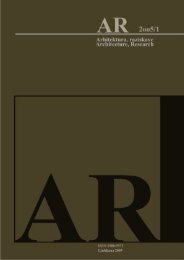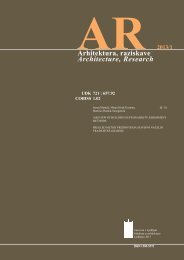AR 2010/1 - Fakulteta za arhitekturo - Univerza v Ljubljani
AR 2010/1 - Fakulteta za arhitekturo - Univerza v Ljubljani
AR 2010/1 - Fakulteta za arhitekturo - Univerza v Ljubljani
You also want an ePaper? Increase the reach of your titles
YUMPU automatically turns print PDFs into web optimized ePapers that Google loves.
<strong>AR</strong> <strong>2010</strong> / 1<br />
<strong>AR</strong> <strong>2010</strong>/1<br />
Lara Slivnik<br />
AN OVERVIEW OF MUSHROOM STRUCTURES<br />
IN SLOVENE STRUCTURALISM<br />
Third International Congress on Construction History,<br />
Brandenburg University of Technology, Cottbus, Germany,<br />
20th - 24th May 2009,<br />
http://www.ch2009.de/<br />
Mednarodni kongres prirejajo na tri leta in udeležijo se ga<br />
arhitekti, gradbeniki, umetnostni zgodovinarji in vsi tisti, ki se<br />
ukvarjajo z zgodovine gradnje od prvih človekovih <strong>za</strong>četkov<br />
do arhitekture moderne. Na kongresu je bilo predstavljenih šest<br />
uvodnih predavanj in preko 200 prispevkov. Referat o gobastih<br />
konstrukcijah v slovenskem strukturalizmu je bil predavan v<br />
sekciji "konstrukcije".<br />
Izvleček<br />
This paper is an overview of mushroom and umbrella structures<br />
in Slovenia. It starts with a brief introduction to the development<br />
of mushroom and umbrella structures. The main part of the paper<br />
describes five selected buildings in Slovenia which are all based<br />
upon the idea of a single central column supporting the roof.<br />
All of them were built between 1960 and 1971, a decade when<br />
Structuralism dominated Slovene architecture. The selection has<br />
been made according to their importance for Slovene architecture<br />
and therefore the analysis is made from the architectural point of<br />
view. At the end, various reasons for their sudden disappearance<br />
from Slovene architecture after 1970 are discussed.<br />
SLIVNIK, Lara. An overview of mushroom structures in Slovene<br />
structuralism. V: KURRER, Karl-Eugen (ur.), LORENZ, Werner<br />
(ur.), WETZK, Volker (ur.). Proceedings of the Third International<br />
Congress on Construction History, Brandenburg University<br />
of Technology Cottbus, Germany 20th - 24th May 2009.<br />
Vol.3. Cottbus: Chair of Construction History and Structural<br />
Preservation of the Brandenburg University of Technology, cop.<br />
2009, str. 1339-1346, ilustr. [COBISS.SI-ID 2294148]<br />
Martina Zbašnik-Senegačnik<br />
PASSIVE HOUSE IN SLOVENIA<br />
1 st Alps-Adria Conference on Passive Houses, Pecs,<br />
Madžarska,<br />
4.-5. september 2009<br />
http://www.matserv.pmmf.hu/passzivhaz/index_en.html<br />
Vabljeno predavanje na mednarodni konferenci<br />
Abstract<br />
The environmental attitude has grown also in Slovenia,<br />
although not as fast as Austria, Germany and Switzerland.<br />
There is a growing interest for ecological materials, for very<br />
low energy houses and in last year also for the passive houses.<br />
Large shifts occurred in 2008 in the introduction of passive<br />
houses into Slovenia. These shifts were undoubtedly the result<br />
of all the activities that had been carried out in previous years.<br />
We can divide these activities into two areas: promotional<br />
activities (Articles in the popular and professional reviews, The<br />
monograph ‘The Passive House’, Presentations of the passive<br />
house, Construction fairs in Ljubljana and Gornja Radgona,<br />
Professional trainings and seminars, Production of an educational<br />
film on the construction of a passive house, Media support,<br />
Activities towards the construction of a trial settlement of passive<br />
houses in Slovenia, Saint-Gobain Isover student competition)<br />
and concrete measures to introduce energy-efficiency standards<br />
into buildings (Subsidies for the construction of energy-efficient<br />
houses, The Passive House Consortium, Education and training<br />
for the planning of passive house construction, Rules on the<br />
Efficient Use of Energy in Buildings). In the article the activities<br />
in last year will be described.<br />
Predavanje je kot članek objavljeno v: ZBAŠNIK-SENEGAČNIK,<br />
Martina. Passive house in Slovenia. V: 1st Alps-Adria Conference<br />
on Passive Houses, Pecs, 4-5 September 2009 : proceedings.<br />
Pecs: Alps-Adria Conference on Passive Houses, 2009, str. [1-<br />
6]. [COBISS.SI-ID 2324612]<br />
Martina Zbašnik-Senegačnik<br />
HOW MUCH DOES THE PASSIVE HOUSE<br />
COST?<br />
1 st Alps-Adria Conference on Passive Houses, Pecs, Madžarska,<br />
4.-5. september 2009<br />
http://www.matserv.pmmf.hu/passzivhaz/index_en.html<br />
Abstract<br />
Lately, the term “passive house” has been gaining ground in<br />
Slovenia, representing the most favourable cost-benefit ratio<br />
– energy saving – to date. A passive house uses less than 15<br />
kWh/(m 2 a) in heating energy. There still remains the conviction<br />
among laymen, as well as among experts, that passive houses<br />
are expensive. This paper describes a high-quality lowenergy<br />
family house in the vicinity of Ljubljana and outlines<br />
a comparison of the actual cost of its construction and a cost<br />
estimate for the construction of a passive house.<br />
The analysis of approximate costs of the construction of a<br />
passive house, therefore, shows that in Slovenia the price should<br />
not exceed the price of a high-quality, thoroughly designed and<br />
built low-energy house by more than 10 %.<br />
ZBAŠNIK-SENEGAČNIK, Martina. How much does the passive<br />
house cost?. V: 1st Alps-Adria Conference on Passive Houses,<br />
Pecs, 4-5 September 2009 : proceedings. Pecs: Alps-Adria<br />
Conference on Passive Houses, 2009, str. 1-6, ilustr. [COBISS.<br />
SI-ID 2324868]<br />
90

















